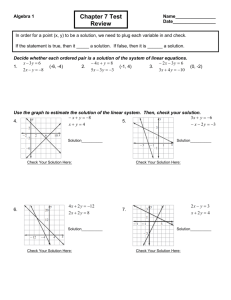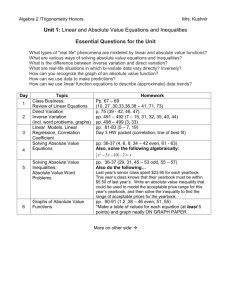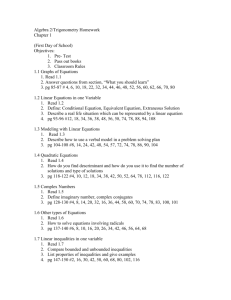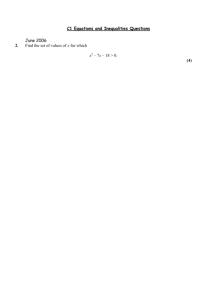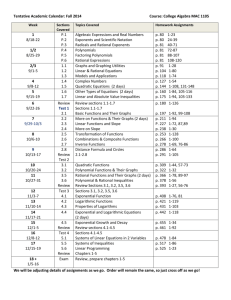Curriculum Map Discipline: Science Course: Physics Teacher: Matt
advertisement
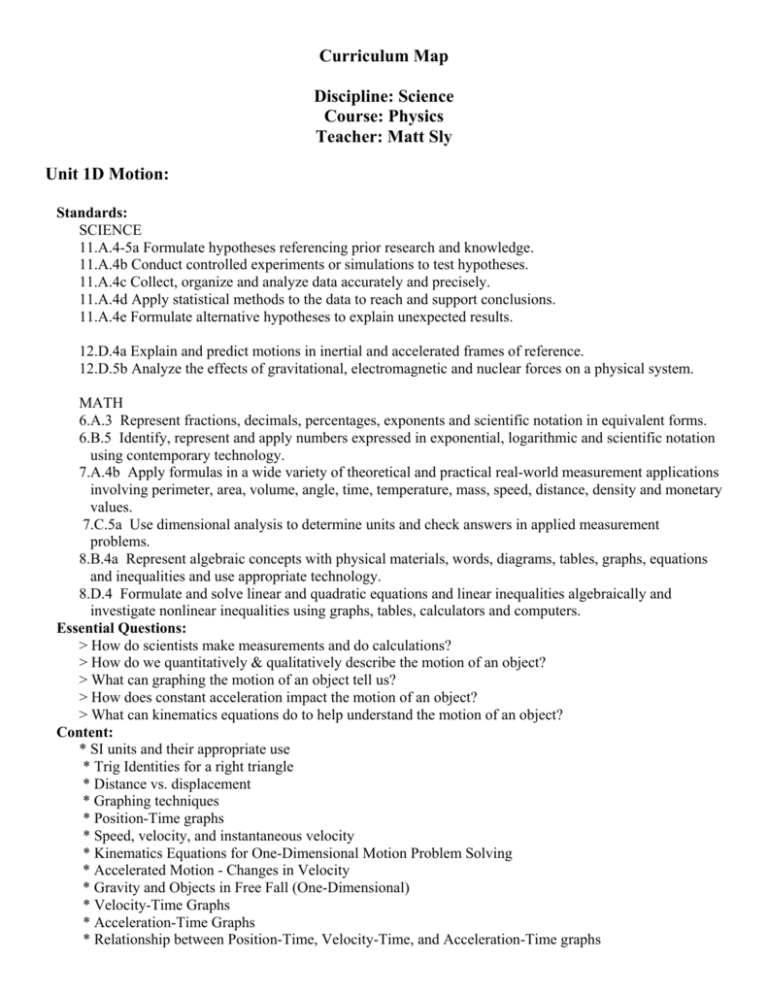
Curriculum Map Discipline: Science Course: Physics Teacher: Matt Sly Unit 1D Motion: Standards: SCIENCE 11.A.4-5a Formulate hypotheses referencing prior research and knowledge. 11.A.4b Conduct controlled experiments or simulations to test hypotheses. 11.A.4c Collect, organize and analyze data accurately and precisely. 11.A.4d Apply statistical methods to the data to reach and support conclusions. 11.A.4e Formulate alternative hypotheses to explain unexpected results. 12.D.4a Explain and predict motions in inertial and accelerated frames of reference. 12.D.5b Analyze the effects of gravitational, electromagnetic and nuclear forces on a physical system. MATH 6.A.3 Represent fractions, decimals, percentages, exponents and scientific notation in equivalent forms. 6.B.5 Identify, represent and apply numbers expressed in exponential, logarithmic and scientific notation using contemporary technology. 7.A.4b Apply formulas in a wide variety of theoretical and practical real-world measurement applications involving perimeter, area, volume, angle, time, temperature, mass, speed, distance, density and monetary values. 7.C.5a Use dimensional analysis to determine units and check answers in applied measurement problems. 8.B.4a Represent algebraic concepts with physical materials, words, diagrams, tables, graphs, equations and inequalities and use appropriate technology. 8.D.4 Formulate and solve linear and quadratic equations and linear inequalities algebraically and investigate nonlinear inequalities using graphs, tables, calculators and computers. Essential Questions: > How do scientists make measurements and do calculations? > How do we quantitatively & qualitatively describe the motion of an object? > What can graphing the motion of an object tell us? > How does constant acceleration impact the motion of an object? > What can kinematics equations do to help understand the motion of an object? Content: * SI units and their appropriate use * Trig Identities for a right triangle * Distance vs. displacement * Graphing techniques * Position-Time graphs * Speed, velocity, and instantaneous velocity * Kinematics Equations for One-Dimensional Motion Problem Solving * Accelerated Motion - Changes in Velocity * Gravity and Objects in Free Fall (One-Dimensional) * Velocity-Time Graphs * Acceleration-Time Graphs * Relationship between Position-Time, Velocity-Time, and Acceleration-Time graphs * Reaction Time - based on acceleration Skills: * SI units and their appropriate use * Trig Identities for a right triangle * Distance vs. displacement * Graphing techniques * Position-Time graphs * Speed, velocity, and instantaneous velocity * Kinematics Equations for One-Dimensional Motion Problem Solving * Accelerated Motion - Changes in Velocity * Gravity and Objects in Free Fall (One-Dimensional) * Velocity-Time Graphs * Acceleration-Time Graphs * Relationship between Position-Time, Velocity-Time, and Acceleration-Time graphs * Reaction Time - based on acceleration Assessment: * Math Skills Quiz * Position-Time Graph & Velocity-Time Graph Quiz * Various problem solving homework assignments * Labs: Position v. Time Graphing and Velocity v. Time Graphing * Group Worksheets: Position v. Time Graphing and Velocity v. Time Graphing * Accelerated Motion Lab * Free-fall Worksheet * Accelerated Motion Quiz (kinematics equations and v-t graph) Unit - Forces: Standards: SCIENCE 11.A.4-5a Formulate hypotheses referencing prior research and knowledge. 11.A.4b Conduct controlled experiments or simulations to test hypotheses. 11.A.4c Collect, organize and analyze data accurately and precisely. 11.A.4d Apply statistical methods to the data to reach and support conclusions. 11.A.4e Formulate alternative hypotheses to explain unexpected results. 12.D.4a Explain and predict motions in inertial and accelerated frames of reference. 12.D.5b Analyze the effects of gravitational, electromagnetic and nuclear forces on a physical system. MATH 6.A.3 Represent fractions, decimals, percentages, exponents and scientific notation in equivalent forms. 6.B.5 Identify, represent and apply numbers expressed in exponential, logarithmic and scientific notation using contemporary technology. 7.A.4b Apply formulas in a wide variety of theoretical and practical real-world measurement applications involving perimeter, area, volume, angle, time, temperature, mass, speed, distance, density and monetary values. 7.C.5a Use dimensional analysis to determine units and check answers in applied measurement problems. 8.B.4a Represent algebraic concepts with physical materials, words, diagrams, tables, graphs, equations and inequalities and use appropriate technology. 8.D.4 Formulate and solve linear and quadratic equations and linear inequalities algebraically and investigate nonlinear inequalities using graphs, tables, calculators and computers. Essential Questions: > Why do objects move? > What are the types of forces we deal with in the world? > How do Newton's Laws of Motion help us understand the motion of objects? > What are the types of friction and how do use them to understand motion? > How does Net Force determine the motion of an object? Content: * Force - field forces vs. mechanical forces * Newton's Laws of Motion * Free Body Diagrams * Mass vs. Weight * Frictional Force effects on motion * Kinetic vs. Static Friction * Net Force - The cause of acceleration * Terminal Velocity - The Balancing of Forces Skills: * Utilize F = ma in problem solving * Apply Newton's Laws to understand accelerated motion * Recognize Net Force as the sum of all forces acting on an object * Create a fee body diagram of forces acting on an object in one dimension * Utilize F = ma in solving problems with force * Recognize motion equations are still a fundamental part of the work they are doing with Force * Diagram forces at work in each problem, to indicate magnitude and direction -> including Fw, FN, Ff and Fa * Compare the concept of mass and weight * Describe Net Force and how it can be used to solve specific force problems. * Recognize Newton's 3rd Law and how it relates to two separate objects * Recognize and describe the difference between static and kinetic friction. * Describe the coefficient of friction * Utilize coefficient of friction to determine the force of friction on an object. * Recognize relationship between Weight and Normal Force. * Measure the coefficient of friction between two surfaces. * Determine the effects of weight and surface area on the coefficient of friction * Make connections between terminal velocity and air resistance to net forces acting on an object. Assessment: * Application of Newton's Laws Pop Quiz * Determining the Coefficient of Friction Lab * Force Quiz * Friction Worksheet * Force Assessment (Chapter 5) * Various Problem Solving Homework Assignments * Completion of Physics Journal * Fall Semester Exam Unit - Vectors: Standards: SCIENCE 11.A.4-5a Formulate hypotheses referencing prior research and knowledge. 11.A.4b Conduct controlled experiments or simulations to test hypotheses. 11.A.4c Collect, organize and analyze data accurately and precisely. 11.A.4d Apply statistical methods to the data to reach and support conclusions. 11.A.4e Formulate alternative hypotheses to explain unexpected results. 12.D.4a Explain and predict motions in inertial and accelerated frames of reference. 12.D.5b Analyze the effects of gravitational, electromagnetic and nuclear forces on a physical system. MATH 6.A.3 Represent fractions, decimals, percentages, exponents and scientific notation in equivalent forms. 6.B.5 Identify, represent and apply numbers expressed in exponential, logarithmic and scientific notation using contemporary technology. 7.A.4b Apply formulas in a wide variety of theoretical and practical real-world measurement applications involving perimeter, area, volume, angle, time, temperature, mass, speed, distance, density and monetary values. 7.C.5a Use dimensional analysis to determine units and check answers in applied measurement problems. 8.B.4a Represent algebraic concepts with physical materials, words, diagrams, tables, graphs, equations and inequalities and use appropriate technology. 8.D.4 Formulate and solve linear and quadratic equations and linear inequalities algebraically and investigate nonlinear inequalities using graphs, tables, calculators and computers. 9.D.4 Analyze and solve problems involving triangles (e.g., distances which cannot be measured directly) using trigonometric ratios. Essential Questions: > How do vectors differ from scalars? > How do you add vectors? > How can vectors be used to understand the motion of an object? > What is the relationship between perpendicular vectors? > How can vectors be broken down into components? Content: * Graphical Method and Parallelogram Method of Adding Vectors * Analytical Method of Vector Addition * Applications of Vectors to 1-D & 2-D Motion * Using kinematics equations with vectors Skills: * Identify two methods of vector addition (graphical and analytical) * Compare the parallelogram rule to the graphical "tip-to-tail" method of vector addition * Recognize the independence of perpendicular vector quantities * Demonstrate an ability to add vectors, through a combination of methods of vector addition * Recognize that order does not matter in vector addition * Utilize trig functions (sin, cos and tan) to solve vector addition problems * Design an experiment to prove the independence of perpendicular vectors * Utilize trig functions (sin, cos and tan) in vector resolution * Add vectors at any angle by adding X and Y components * Recognize specific aspects of inclined planes that are relevant to vector resolution. Assessment: * Perpendicular Vector Addition Quiz * Vector Addition Test (Chap 6) * Vector Addition Worksheet * Inclined Plane Worksheet * Vector Addition at Any Angle & Vector Resolution Problem Creation Activity * Various Problem Solving Homework Assignments * Completion of Physics Journal * Fall Semester Exam Unit 2D - Motion: Standards: SCIENCE 11.A.4-5a Formulate hypotheses referencing prior research and knowledge. 11.A.4b Conduct controlled experiments or simulations to test hypotheses. 11.A.4c Collect, organize and analyze data accurately and precisely. 11.A.4d Apply statistical methods to the data to reach and support conclusions. 11.A.4e Formulate alternative hypotheses to explain unexpected results. 12.D.4a Explain and predict motions in inertial and accelerated frames of reference. 12.D.5b Analyze the effects of gravitational, electromagnetic and nuclear forces on a physical system. MATH 6.A.3 Represent fractions, decimals, percentages, exponents and scientific notation in equivalent forms. 6.B.5 Identify, represent and apply numbers expressed in exponential, logarithmic and scientific notation using contemporary technology. 7.A.4b Apply formulas in a wide variety of theoretical and practical real-world measurement applications involving perimeter, area, volume, angle, time, temperature, mass, speed, distance, density and monetary values. 7.C.5a Use dimensional analysis to determine units and check answers in applied measurement problems. 8.B.4a Represent algebraic concepts with physical materials, words, diagrams, tables, graphs, equations and inequalities and use appropriate technology. 8.D.4 Formulate and solve linear and quadratic equations and linear inequalities algebraically and investigate nonlinear inequalities using graphs, tables, calculators and computers. 9.D.4 Analyze and solve problems involving triangles (e.g., distances which cannot be measured directly) using trigonometric ratios. Essential Questions: > How do vectors apply to projectile motion? > What are the forces working on a projectile? > How does horizontal projectile motion differ from objects launched at an angle? > How is the trajectory of projectile motion symmetric? > What are features that might impact the range of a projectile? Content: Projectile Motion * Horizontal Launched Projectile Motion * Objects Launched at an Angle Science in Film * Exploring the roots of rocketry in the U.S. Skills: Projectile Motion * Recognize the independence of perpendicular vector quantities * Utilize motion equations for X and Y direction * Apply notion that there is no acceleration in the X direction, if air resistance is ignored * Solve problems involving an object being launched horizontally * Solve problems involving an object being launched at an angle Science in Film * Examine the application of physics in rocketry * Appreciate the efforts made in rocketry in the 1950's * Recognize the historical influences in rocket & space exploration * Identify social and personal factors that influence science * Explain at least one personal opinion on the purpose for science. * Identify connections between physics class projectile motion problems and real world applications. Assessment: * Chapter 7 Test on Projectile Motion * Horizontal Projectile Motion Worksheet * Projectile Motion Quiz * Projectile Launched at Any Angle Worksheet * Projectile Launched at Any Angle Pop Quiz * Projectile Launched at Any Angle Motion Quiz Creation & Participation * Various Problem Solving Homework Assignments * Completion of Physics Journal Unit - Circular: Standards: SCIENCE 11.A.4-5a Formulate hypotheses referencing prior research and knowledge. 11.A.4b Conduct controlled experiments or simulations to test hypotheses. 11.A.4c Collect, organize and analyze data accurately and precisely. 11.A.4d Apply statistical methods to the data to reach and support conclusions. 11.A.4e Formulate alternative hypotheses to explain unexpected results. 12.D.4a Explain and predict motions in inertial and accelerated frames of reference. 12.D.5b Analyze the effects of gravitational, electromagnetic and nuclear forces on a physical system. MATH 6.A.3 Represent fractions, decimals, percentages, exponents and scientific notation in equivalent forms. 6.B.5 Identify, represent and apply numbers expressed in exponential, logarithmic and scientific notation using contemporary technology. 7.A.4b Apply formulas in a wide variety of theoretical and practical real-world measurement applications involving perimeter, area, volume, angle, time, temperature, mass, speed, distance, density and monetary values. 7.C.5a Use dimensional analysis to determine units and check answers in applied measurement problems. 8.B.4a Represent algebraic concepts with physical materials, words, diagrams, tables, graphs, equations and inequalities and use appropriate technology. 8.D.4 Formulate and solve linear and quadratic equations and linear inequalities algebraically and investigate nonlinear inequalities using graphs, tables, calculators and computers. Essential Questions: > What are some examples of circular motion? > What forces must be considered in circular motion? > How does torque impact circular motion? > How does simple harmonic motion work? > How does resonance impact simple harmonic motion? Content: * Circular Motion * Torque * Simple Harmonic Motion * Resonance Skills: * Identify properties of a circle used in understanding circular motion * Recognize circular motion equations for centripetal force and acceleration * Identify directions of centripetal force and velocity of object traveling in circle * Recognize a change in circular motion is caused by torque * Identify components necessary to solve torque problems, including force and length of lever arm * Characterize simple harmonic motion * Compare simple harmonic motion to other examples of periodic motion * Apply Newton's Laws to objects moving in simple harmonic motion * Utilize SHM equation to find length or period in a given pendulum * Characterize simple harmonic motion in terms of velocity, acceleration, force, and displacement * Analyze specific parts of pendulum's motion * Define and recognize examples of Mechanical Resonance Assessment: * Sling Lab - Using Circular Motion * Projectile Motion (at an angle), Circular Motion, and Torque Quiz * Clockmaking Lab * Various Problem Solving Homework Assignments * Completion of Physics Journal Unit - Gravitation: Standards: SCIENCE 11.A.4-5a Formulate hypotheses referencing prior research and knowledge. 11.A.4b Conduct controlled experiments or simulations to test hypotheses. 11.A.4c Collect, organize and analyze data accurately and precisely. 11.A.4d Apply statistical methods to the data to reach and support conclusions. 11.A.4e Formulate alternative hypotheses to explain unexpected results. 12.D.4a Explain and predict motions in inertial and accelerated frames of reference. 12.D.5b Analyze the effects of gravitational, electromagnetic and nuclear forces on a physical system. MATH 6.A.3 Represent fractions, decimals, percentages, exponents and scientific notation in equivalent forms. 6.B.5 Identify, represent and apply numbers expressed in exponential, logarithmic and scientific notation using contemporary technology. 7.A.4b Apply formulas in a wide variety of theoretical and practical real-world measurement applications involving perimeter, area, volume, angle, time, temperature, mass, speed, distance, density and monetary values. 7.C.5a Use dimensional analysis to determine units and check answers in applied measurement problems. 8.B.4a Represent algebraic concepts with physical materials, words, diagrams, tables, graphs, equations and inequalities and use appropriate technology. 8.D.4 Formulate and solve linear and quadratic equations and linear inequalities algebraically and investigate nonlinear inequalities using graphs, tables, calculators and computers. Essential Questions: > How has our view of the cosmos changed over time? > What do Kepler's Three Laws tell us about an orbiting body? > How does Newton's Universal Gravitation explain the relation ship between any two masses? > What connections can be found between Kepler's 3rd Law, Universal Gravitation equation, and circular motion? > How do gravitational fields help explain observations of gravity? Content: * Geocentric vs. Heliocentric Debate - A Historical Examination of Astronomy * Examining Space & Gravity from the Human Perspective * Kepler's Three Laws of Planetary Motion * Newton's Universal Gravitation * Connecting Kepler & Newton through derivation * Weightlessness vs. Free Fall * Satellite Orbits * Planetary Differences Skills: * Identify effects a weightless environment has on humans * Identify possible solutions to low gravity environmental problems * Explain the repercussions a long space journey (i.e. to Mars) might have on humans * Express some personal thoughts on the issues of space travel and the problems that might arise * Identify Kepler's Three Laws of Planetary Motion * Use Kepler's Third Law to determine the Period or radius of an orbiting object. * Explain Kepler's Second Law in terms of actual orbiting objects * Use Kepler's Third Law to determine the Period or radius of an orbiting object. * Identify relationship between distance and force of gravity on two objects. * Use Newton's Universal Gravitation equation to calculate the gravitational force between two bodies. * Use Newton's Universal Gravitation and Kepler's Three Laws to give basic explanation of modern space flight. * Identify and describe models of planetary systems similar and different to our solar system * Develop a form of Kepler's Third Law based on Newton's Universal Gravitation. * Make connections between circular motion and orbital motion * Explain the difference between zero gravity and the feeling of "weightlessness" felt in space. * Use Newton's Universal Gravitation and Kepler's Three Laws to give basic explanation of modern space flight. * Describe and utilize Kepler's Three Laws of Planetary Motion * Calculate gravitational force between two objects using Newton's Gravitation equation * Calculate mass of orbited object based on orbiting body's information. · Explain the difference between zero gravity and the feeling of "weightlessness" felt in space. * Identify the concept of Gravitational Fields * Identify Einstein's Theory of Gravity and the supporting astronomical evidence * Identify basic properties and characteristics of the planets of our Solar System * Discuss the distinguishing features of Earth and why these make life possible here. * Explain the difference between inner and outer planets * Discuss possible explanations for how the solar system formed * Discuss features of Jupiter, Saturn and asteroids as well. Assessment: * Universal Gravitation Worksheet * Satellite Worksheet * The Orbit - Ellipse Lab * Various Problem Solving Homework Assignments * Completion of Physics Journal * Chapter 8 Quiz - Newton & Kepler * Chapter 8 Test - Universal Gravitation Unit - Momentum: Standards: SCIENCE 11.A.4-5a Formulate hypotheses referencing prior research and knowledge. 11.A.4b Conduct controlled experiments or simulations to test hypotheses. 11.A.4c Collect, organize and analyze data accurately and precisely. 11.A.4d Apply statistical methods to the data to reach and support conclusions. 11.A.4e Formulate alternative hypotheses to explain unexpected results. 12.D.4a Explain and predict motions in inertial and accelerated frames of reference. 12.D.5b Analyze the effects of gravitational, electromagnetic and nuclear forces on a physical system. MATH 6.A.3 Represent fractions, decimals, percentages, exponents and scientific notation in equivalent forms. 6.B.5 Identify, represent and apply numbers expressed in exponential, logarithmic and scientific notation using contemporary technology. 7.A.4b Apply formulas in a wide variety of theoretical and practical real-world measurement applications involving perimeter, area, volume, angle, time, temperature, mass, speed, distance, density and monetary values. 7.C.5a Use dimensional analysis to determine units and check answers in applied measurement problems. 8.B.4a Represent algebraic concepts with physical materials, words, diagrams, tables, graphs, equations and inequalities and use appropriate technology. 8.D.4 Formulate and solve linear and quadratic equations and linear inequalities algebraically and investigate nonlinear inequalities using graphs, tables, calculators and computers. Essential Questions: > What is the relationship between mass and velocity with respect to momentum? > How does momentum relate to impulse? > How is momentum conserved? > How does momentum impact things moving in circular motion? Content: * Momentum * Impulse-Momentum Theorem * Law of Conservation of Momentum Skills: * Define and recognize symbol for impulse and momentum * Identify the impulse-momentum theorem * Utilize the impulse-momentum theorem to solve problems * Demonstrate the ability to convert units of basic SI units. * Identify the aspects of conservation of momentum problems, specifically mass and velocity. * Apply the conservation of momentum to simple closed, isolated systems to determine mass and velocity. * Use the conservation of momentum in simple, closed, isolated systems to determine mass and velocity. * Apply linear momentum to physical examples (Newton's Cradle and The Explosion) * Examine the practical use for understanding momentum (developing highway barricades) * Identify the major components of angular momentum and what effect they have on the motion of a rotating object. Assessment: * Chapter 9 Test - Momentum * Work, Power & Simple Machines Quiz * Unit Conversion Pop Quiz (part 1) * Unit Conversion Pop Quiz (part 2) * Momentum Stations Lab * Inquiry Lab: Work & Power * Various Problem Solving Homework Assignments * Completion of Physics Journal Unit - Work: Standards: SCIENCE 11.A.4-5a Formulate hypotheses referencing prior research and knowledge. 11.A.4b Conduct controlled experiments or simulations to test hypotheses. 11.A.4c Collect, organize and analyze data accurately and precisely. 11.A.4d Apply statistical methods to the data to reach and support conclusions. 11.A.4e Formulate alternative hypotheses to explain unexpected results. 12.D.4a Explain and predict motions in inertial and accelerated frames of reference. 12.D.5b Analyze the effects of gravitational, electromagnetic and nuclear forces on a physical system. MATH 6.A.3 Represent fractions, decimals, percentages, exponents and scientific notation in equivalent forms. 6.B.5 Identify, represent and apply numbers expressed in exponential, logarithmic and scientific notation using contemporary technology. 7.A.4b Apply formulas in a wide variety of theoretical and practical real-world measurement applications involving perimeter, area, volume, angle, time, temperature, mass, speed, distance, density and monetary values. 7.C.5a Use dimensional analysis to determine units and check answers in applied measurement problems. 8.B.4a Represent algebraic concepts with physical materials, words, diagrams, tables, graphs, equations and inequalities and use appropriate technology. 8.D.4 Formulate and solve linear and quadratic equations and linear inequalities algebraically and investigate nonlinear inequalities using graphs, tables, calculators and computers. Essential Questions: > What is the relationship between force & distance when discussing work? > What factors change the amount of power output when doing work? > How does mechanical advantage & ideal mechanical advantage impact the use of machines? > What are some examples of simple machines & how do they help us do work? Content: * Work & Direction of Force * Power * Simple Machines * Energy Conservation * Mechanical Advantage Skills: * Define work and power, and the equations for calculating each. * Identify the key components that make up work, and in what direction the force must be applied * Identify the force that does the work * Explain the relationship between work done and energy transferred * Recognize proper units of power (Watt) and work (Joule) * Utilize background knowledge to develop a testable hypothesis on work and power, gather data and verify results. * Identify and explain relationship between work input and work output * Explain the concept of mechanical advantage in ideal and real machines, utilizing it while problem solving * Identify components of MA and IMA, as well as calculate each * Recognize and compute efficiency of simple machines * Identify the six simple machines and the method used to calculate IMA on several of these. * Recognize the relationship between distance and force used in simple machines * Explain the concept of mechanical advantage in ideal and real machines, utilizing it while problem solving * Recognize and compute efficiency of simple machines Assessment: * Finding Work @ UHS Lab * Examining Ramps Lab * Chapter 10 Quiz on Work * Various Problem Solving Homework Assignments * Completion of Physics Journal Unit - Energy: Standards: SCIENCE 11.A.4-5a Formulate hypotheses referencing prior research and knowledge. 11.A.4b Conduct controlled experiments or simulations to test hypotheses. 11.A.4c Collect, organize and analyze data accurately and precisely. 11.A.4d Apply statistical methods to the data to reach and support conclusions. 11.A.4e Formulate alternative hypotheses to explain unexpected results. 12.D.4a Explain and predict motions in inertial and accelerated frames of reference. 12.D.5b Analyze the effects of gravitational, electromagnetic and nuclear forces on a physical system. MATH 6.A.3 Represent fractions, decimals, percentages, exponents and scientific notation in equivalent forms. 6.B.5 Identify, represent and apply numbers expressed in exponential, logarithmic and scientific notation using contemporary technology. 7.A.4b Apply formulas in a wide variety of theoretical and practical real-world measurement applications involving perimeter, area, volume, angle, time, temperature, mass, speed, distance, density and monetary values. 7.C.5a Use dimensional analysis to determine units and check answers in applied measurement problems. 8.B.4a Represent algebraic concepts with physical materials, words, diagrams, tables, graphs, equations and inequalities and use appropriate technology. 8.D.4 Formulate and solve linear and quadratic equations and linear inequalities algebraically and investigate nonlinear inequalities using graphs, tables, calculators and computers. Essential Questions: > What are some types of energy we encounter on a regular basis? > How do kinetic & potential energy relate to each other? > What is the relationship between work & energy? > How are the laws of physics related to amusement rides? Content: Energy * Energy in various forms * Kinetic & Potential Energy * Work-Energy Theorem * Conservation of Energy Amusement Park Physics * Physics Field Trip to Six Flags -or- Internet Project Skills: Energy * Define Kinetic and Potential Energy * Calculate kinetic and gravitational potential energy within problems * Utilize the work-energy theorem to solve problems * Identify relationship between KE and PE within a closed, isolated system. * Recognize the transfer of energy between kinetic and potential in common examples. * State the law of conservation of energy * Utilize the conservation of energy to solve problems * Recognize the transfer of energy between kinetic and potential in common examples. * Identify the relationship of KE & PE within elastic and inelastic collisions Amusement Park Physics * Apply kinematics to aspects of amusement park rides in order to determine velocity, acceleration, forces, and directions. * Recognize and apply aspects of circular motion to rides found in amusement parks. * Identify and relate the transfer of energy found in amusement park rides to other objects. * Utilize other physics concepts to understand the motion and behavior of the human body on these types of rides. Assessment: * Chapter 10 & 11 Test - Work & Energy * KE-PE Lab * Amusement Park Physics Worksheet (or Internet Assignment) * Various Problem Solving Homework Assignments * Completion of Physics Journal Unit - Waves: Standards: SCIENCE 11.A.4-5a Formulate hypotheses referencing prior research and knowledge. 11.A.4b Conduct controlled experiments or simulations to test hypotheses. 11.A.4c Collect, organize and analyze data accurately and precisely. 11.A.4d Apply statistical methods to the data to reach and support conclusions. 11.A.4e Formulate alternative hypotheses to explain unexpected results. 12.D.4a Explain and predict motions in inertial and accelerated frames of reference. 12.D.5b Analyze the effects of gravitational, electromagnetic and nuclear forces on a physical system. MATH 6.A.3 Represent fractions, decimals, percentages, exponents and scientific notation in equivalent forms. 6.B.5 Identify, represent and apply numbers expressed in exponential, logarithmic and scientific notation using contemporary technology. 7.A.4b Apply formulas in a wide variety of theoretical and practical real-world measurement applications involving perimeter, area, volume, angle, time, temperature, mass, speed, distance, density and monetary values. 7.C.5a Use dimensional analysis to determine units and check answers in applied measurement problems. 8.B.4a Represent algebraic concepts with physical materials, words, diagrams, tables, graphs, equations and inequalities and use appropriate technology. 8.D.4 Formulate and solve linear and quadratic equations and linear inequalities algebraically and investigate nonlinear inequalities using graphs, tables, calculators and computers. Essential Questions: > What is the difference between a mechanical and an electromagnetic wave? > How does a transverse wave differ from longitudinal wave? > What is the process of interference? > How does a wave behave when it changes medium? > What determines the speed, amplitude and wavelength of a wave? Content: * Wave Properties: Frequency, Wavelength, Velocity, and amplitude * Types of Waves: Transverse, Longitudinal, Surface * Superposition of Waves: Constructive & Destructive Interference * Wave actions at boundaries: reflection and transmission * Standing Waves Skills: * Recognize that waves transfer energy without transferring matter * Distinguish between a longitudinal and transverse wave * Define and identify wavelength, frequency, period, and amplitude * State the relationship between speed, wavelength, and frequency and utilize this relationship to solve problems * Recognize the difference between mechanical waves (medium) and electromagnetic waves (no medium) * Identify the speed of electromagnetic waves is a constant 3.0x108 m/s * Recognize that wave speed depends on the medium. * Identify changes in waves as they cross the boundary between two media with different wave speeds. * Solve problems involving wave crossing boundaries * State the principal of superposition * Identify the effects of constructive and destructive interference and the resulting wave. * Recognize situations that can create a standing wave and the superposition effects * Identify and describe nodes and antinodes in standing waves * Identify and utilize the Law of Reflection * Identify and describe refraction and diffraction Assessment: * Introduction to Waves Quiz * Snakey Lab - Examining Mechanical Waves * Various Problem Solving Homework Assignments * Completion of Physics Journal Unit - Sound: Standards: SCIENCE 11.A.4-5a Formulate hypotheses referencing prior research and knowledge. 11.A.4b Conduct controlled experiments or simulations to test hypotheses. 11.A.4c Collect, organize and analyze data accurately and precisely. 11.A.4d Apply statistical methods to the data to reach and support conclusions. 11.A.4e Formulate alternative hypotheses to explain unexpected results. 12.D.4a Explain and predict motions in inertial and accelerated frames of reference. 12.D.5b Analyze the effects of gravitational, electromagnetic and nuclear forces on a physical system. MATH 6.A.3 Represent fractions, decimals, percentages, exponents and scientific notation in equivalent forms. 6.B.5 Identify, represent and apply numbers expressed in exponential, logarithmic and scientific notation using contemporary technology. 7.A.4b Apply formulas in a wide variety of theoretical and practical real-world measurement applications involving perimeter, area, volume, angle, time, temperature, mass, speed, distance, density and monetary values. 7.C.5a Use dimensional analysis to determine units and check answers in applied measurement problems. 8.B.4a Represent algebraic concepts with physical materials, words, diagrams, tables, graphs, equations and inequalities and use appropriate technology. 8.D.4 Formulate and solve linear and quadratic equations and linear inequalities algebraically and investigate nonlinear inequalities using graphs, tables, calculators and computers. Essential Questions: > How does doppler effect impact the frequency of sound you hear? > What impact does amplitude of a sound wave impact the volume? > What impact does resonance have on a sound wave? > How does a closed-pipe resonator differ from an open-pipe resonator? > How does the speed of sound change with the medium in which it is traveling? Content: * Sound Waves - longitudinal vs. pressure * Doppler Shift * Pitch and Loudness * The Human Ear * Resonance Skills: * Demonstrate knowledge of the nature of sound waves * Demonstrate knowledge of the properties of sound waves, which are common among all waves * Utilize the decibel scale to relate the energy level in sounds * Solve problems relating the frequency, wavelength, period, and velocity of sound * Define the Doppler shift and identify some of its applications (including solving problems utilizing the Doppler shift equation) * Relate physical properties of sound waves to audible terms such as pitch and loudness * Describe the occurrence of resonance, as it applies to a column of air (for sound waves) * Sketch or diagram closed and open pipe resonators with a standing wave, nodes and antinodes. * Solve problems relating to open and closed pipe resonators * Identify the relationship between mach numbers and the speed of sound * Recognize the characteristics of breaking the sound barrier and creating a sonic boom * Utilize equations relating wavelength, velocity, frequency, and period for sound and other types of waves to solve problems Assessment: * Closed-Pipe Resonance Inquiry Lab * Waves & Sound Test - Chapters 14 & 15 * Various Problem Solving Homework Assignments * Completion of Physics Journal Unit - Light: Standards: SCIENCE 11.A.4-5a Formulate hypotheses referencing prior research and knowledge. 11.A.4b Conduct controlled experiments or simulations to test hypotheses. 11.A.4c Collect, organize and analyze data accurately and precisely. 11.A.4d Apply statistical methods to the data to reach and support conclusions. 11.A.4e Formulate alternative hypotheses to explain unexpected results. 12.D.4a Explain and predict motions in inertial and accelerated frames of reference. 12.D.5b Analyze the effects of gravitational, electromagnetic and nuclear forces on a physical system. MATH 6.A.3 Represent fractions, decimals, percentages, exponents and scientific notation in equivalent forms. 6.B.5 Identify, represent and apply numbers expressed in exponential, logarithmic and scientific notation using contemporary technology. 7.A.4b Apply formulas in a wide variety of theoretical and practical real-world measurement applications involving perimeter, area, volume, angle, time, temperature, mass, speed, distance, density and monetary values. 7.C.5a Use dimensional analysis to determine units and check answers in applied measurement problems. 8.B.4a Represent algebraic concepts with physical materials, words, diagrams, tables, graphs, equations and inequalities and use appropriate technology. 8.D.4 Formulate and solve linear and quadratic equations and linear inequalities algebraically and investigate nonlinear inequalities using graphs, tables, calculators and computers. Essential Questions: > How do we see color? > How does polarization affect the light we see? > How can we model the Law of reflection? > How does a rainbow form? > Why do things appear to be a certain color? Content: * Color of Light - the colors we see * Luminous vs. Illuminated bodies * Ray Model diagrams * Reflection vs. Refraction (applications) * Polarization * Pigments & Dyes * Total Internal Reflection Skills: * Recognize that light is an electromagnetic wave and state the wavelength range for light (400 nm 700nm) * Solve problems dealing with speed of light, frequency, and wavelength * State the speed of light to 3 significant digits, identify the constant "c" and utilize in solving problems with light * Identify and explain the functionality of parts of the eye * Identify specific disorders related to the human eye * Identify members of the Electromagnetic spectrum, and their relation based on frequency and wavelength. * Distinguish important relationships between visible light and other EM waves * Define transparent, translucent, and opaque, giving examples of each * Explain the formation of color by adding light or subtracting with pigments or dyes * Identify three primary colors of light: red, green, and blue and secondary colors: yellow, cyan, and magenta * Define luminous intensity, luminous flux, and illuminance * Utilize illuminance equation to solve problems with varying light sources and varying distances * Describe two methods of polarizing light and how this can be applied to other areas of life * State the law of reflection and apply it to light waves * Distinguish between diffuse and regular reflections * Define refraction and determine the bending of a light ray based on changing of medium * State Snell's law and determine angles based on index of refraction and the given media * Relate the index of refraction to the speed of light in a medium and in a vacuum, utilizing this information to solve problems * Explain total internal reflection * Define and explain the critical angle * Identify uses of total internal reflection in fiber optics and jewelry making * Identify refraction effects in creating mirages and other optical illusions * Explain dispersion of light in terms of index of refraction * Explain the process for creating a rainbow Assessment: * Refraction of Light Lab * Polarization of Light Inquiry Activity * Light Quiz * Light Test - Chapters 16 & 17 * Various Problem Solving Homework Assignments * Completion of Physics Journal


